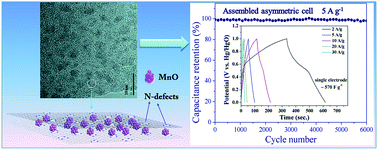Ultrasmall MnO@N-rich carbon nanosheets for high-power asymmetric supercapacitors†
Abstract
Manganese monoxide (MnO) holds great potential for high-performance supercapacitors; however, it is highly desirable to establish a feasible structure to address common concerns of MnO materials. Herein, we have inserted ultrasmall MnO nanoparticles into N-rich carbon nanosheets (MnO@NCs) via a facile and scalable method. By integrating copious nitrogen species (over 13 wt%), flexible but robust carbon nanosheets offer powerful support for dispersing large amounts of MnO nanoparticles, creatively avoiding the inherent deficiencies of MnO such as poor electrical conductivity, low mechanical stability and severe electrochemical dissolution. Consequently, the MnO@NC electrode exhibited a striking capacitance of 570 F g−1 at 2 A g−1 within a wide operation voltage of 1 V, which spurs the low capacitance of MnO materials (generally 200–350 F g−1) to a higher level. Furthermore, initial attempts at fabricating asymmetric supercapacitors based on MnO@NCs demonstrated an energy density superior to its well-studied MnO2 counterpart. The introduction of N-rich species is of great significance for releasing restricted properties and fully exerting positive effects on the supercapacitors. Particularly, the impressive capacitance retention of ∼99% over 6000 cycles also propels a new direction for transition metal oxide/NC composites towards high-performance energy storage devices.


 Please wait while we load your content...
Please wait while we load your content...